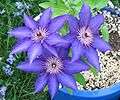Clematis
< Horticulture| Clematis | |
|---|---|
 | |
| Genus: | Clematis |
| Family: | Ranunculaceae |
| Pollination: | Insects |
| Toxicity and edibility: | Mildly toxic |
Clematis is a genus of perennial plants, most of which are vigorous, semiwoody climbing vines, but others are herbaceous perennials or shrubs. They are found throughout the temperate regions of both hemispheres, and also in mountains in the tropics. Most of the cool temperate species are deciduous, while many of the warmer climate species are evergreen.
Most species are known as Clematis in English, while some are also known as traveller's joy, leather flower, vase vine and virgin's bower, the last three being names used for North American species.
One recent classification recognised 297 species of clematis and modern taxonomists subdivide the genus. Magnus Johnson divided Clematis into 19 sections, several with subsections [1]; Christopher Grey-Wilson divided the genus into 9 subgenera, several with sections and subsections within them [2]. Several of the subdivisions are fairly consistent between different classifications, for example all Grey-Wilson's subgenera are used as sections by Johnson.
Subgenera of Clematis according to Grey-Wilson:
- Clematis, Cheiropsis, Flammula, Archiclematis, Campanella, Atragene, Tubulosae, Pseudanemone, Viorna
Some of these were previously classed as separate genera.
Description
Clematis have opposite (or in rare cases alternate), pinnately compound leaves, with the petioles often twining to support the plant. Flowers are borne solitary or in panicles, bell-shaped or flattened. Bisexual or sometimes unisexual, stamens many, carpels numerous. Sepals in 4s or 5s, petal-like, petals lacking. Stamens are petaloid in some species. Fruits are achenes, often with long, feathery styles. Stems contain an acrid sap, and the bark of wody species exfoliates in long strips.
Growing conditions
Deep, organic-rich soils. Most species need their root zones shaded during the growing season. Full sun to part shade.
Maintenance
Young shoots are very delicate in the spring and brittle afterwards, so trellis structures should be installed during winter.
Propagation
Stratified seed, layering, division, cuttings, or in rare cases grafting
Pests and diseases
Crown Gall
- Agrobacterium tumeifasciens
- Erisiphe polygoni
- Cylindrosporium clematidis
- Cercospora rubigo
- Cercospora squalidula
- Glomerella cingulata
- Phyllosticta clematidis
- Ramularia clematidis
- Septoria clematidis
Leaf Blights
- Phleospora adjusta
- Ascochyta clematidina
Mushroom Rots
- Armillaria
- Puccinia pulsatillae
- Puccinia recondita var. agropyri
- Puccinia stromatica
Smuts
- Urocystis carcinoides
- Meliodgyne hapla
- Meliodgyne incognita
- Green Peach Aphid: Myzus persicae
Scales
- Garden Fleahopper: Halticus bractatus
- Black Blister Beetle: Epicuata pennsylvanica
- Japanese Weevil: Callirhopalus bifasciatus
- Clematis Borer: *Alcathoe caudata
Gallery
-

Purple clematis
-

Clematis montana
-
Flowers of Clematis vitalba look different from most other Clematis
-

Seed heads of Clematis vitalba growing in a hedge, showing why it is known colloquially as "Old man's beard"
References
- Grey-Wilson, Christopher Clematis: The Genus : A Comprehensive Guide for Gardeners, Horticulturists and Botanists (Timber Press, 2000)
- Johnson, Magnus The Genus Clematis (Magnus Johnson Plantskola AB, 2001)
- Gardeners' Encyclopedia of Plants and Flowers, Christopher Brickell ed. (Dorling Kindersley, 1989)
- Britton, Nathaniel Lord; Addison Brown (1913). An Illustrated Flora of the Northern United States and Canada, Volume 2 (second edition ed.). Dover Publications, inc.. pp. 121-126.
- Ann Fowler Rhoads and Timothy A. Block (2000). The Plants of Pennsylvania: An Illustrated Manual. Anna Anisko, illustrator. Morris Arboretum, University of Pennsylvania Press. pp. 572-574.
- Christopher Brickell and Judith D. Zuk (1997). The American Horticultural Society A-Z Encyclopedia of Garden Plants. DK Publishing. pp. 274-279.
- Staff of the L. H. Bailey Hortorium (1976). Hortus Third: A Concise Dictionary of Plants Cultivated in the United States and Canada. Cornell University Press. pp. 281-285.
- Pirone, Pascal P. (1978). Diseases & Pests of Ornamental Plants (Fifth Edition ed.). John Wiley & Sons, New York. pp. 205.
- Cranshaw, Whitney (2004). Garden Insects of North America: The Ultimate Guide to Backyard Bugs. Princeton University Press. pp. 588.
- Pippa Greenwood, Andrew Halstead, A.R. Chase, Daniel Gilrein (2000). American Horticultural Society Pests & Diseases: The Complete Guide to Preventing, Identifying, and Treating Plant Problems (First Edition ed.). Dorling Kindersley (DK) Publishing, inc.. pp. 196.
- ↑ http://personal.inet.fi/koti/lofgren/Clemnet/Link_sections.htm#MJo
- ↑ http://personal.inet.fi/koti/lofgren/Clemnet/Link_sections.htm#Gr-W